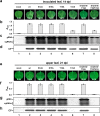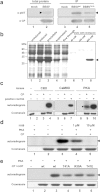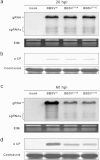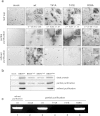Phosphorylation of Beet black scorch virus coat protein by PKA is required for assembly and stability of virus particles
- PMID: 26108567
- PMCID: PMC4479801
- DOI: 10.1038/srep11585
Phosphorylation of Beet black scorch virus coat protein by PKA is required for assembly and stability of virus particles
Abstract
Plant virus coat proteins (CPs) play a fundamental role in protection of genomic RNAs, virion assembly, and viral movement. Although phosphorylation of several CPs during virus infection have been reported, little information is available about CP phosphorylation of the spherical RNA plant viruses. Here, we demonstrate that the CP of Beet black scorch virus (BBSV), a member of the genus Necrovirus, can be phosphorylated at threonine-41 (T41) by cAMP-dependent protein kinase (PKA)-like kinase in vivo and in vitro. Mutant viruses containing a T41A non-phosphorylatable alanine substitution, and a T41E glutamic acid substitution to mimic threonine phosphorylation were able to replicate but were unable to move systemically in Nicotiana benthamiana. Interestingly, the T41A and T41E mutants generated unstable 17 nm virus-like particles that failed to package viral genomic (g) RNA, compared with wild-type BBSV with 30 nm virions during viral infection in N. benthamiana. Further analyses showed that the T41 mutations had little effect on the gRNA-binding activity of the CP. Therefore, we propose a model whereby CP phosphorylation plays an essential role in long-distance movement of BBSV that involves formation of stable virions.
Conflict of interest statement
The authors declare no competing financial interests.
Figures







Similar articles
-
Identification of regions of the Beet mild curly top virus (family Geminiviridae) capsid protein involved in systemic infection, virion formation and leafhopper transmission.Virology. 2005 Oct 25;341(2):257-70. doi: 10.1016/j.virol.2005.07.009. Epub 2005 Aug 8. Virology. 2005. PMID: 16085227
-
A Functional Link between RNA Replication and Virion Assembly in the Potyvirus Plum Pox Virus.J Virol. 2018 Apr 13;92(9):e02179-17. doi: 10.1128/JVI.02179-17. Print 2018 May 1. J Virol. 2018. PMID: 29444942 Free PMC article.
-
N-terminal basic amino acid residues of Beet black scorch virus capsid protein play a critical role in virion assembly and systemic movement.Virol J. 2013 Jun 20;10:200. doi: 10.1186/1743-422X-10-200. Virol J. 2013. PMID: 23786675 Free PMC article.
-
Potyviral coat protein and genomic RNA: A striking partnership leading virion assembly and more.Adv Virus Res. 2020;108:165-211. doi: 10.1016/bs.aivir.2020.09.001. Epub 2020 Sep 18. Adv Virus Res. 2020. PMID: 33837716 Review.
-
Helical capsids of plant viruses: architecture with structural lability.J Gen Virol. 2016 Aug;97(8):1739-1754. doi: 10.1099/jgv.0.000524. Epub 2016 Jun 15. J Gen Virol. 2016. PMID: 27312096 Review.
Cited by
-
Positive selection and recombination shaped the large genetic differentiation of Beet black scorch virus population.PLoS One. 2019 Apr 25;14(4):e0215574. doi: 10.1371/journal.pone.0215574. eCollection 2019. PLoS One. 2019. PMID: 31022219 Free PMC article.
-
Phosphorylation coexists with O-GlcNAcylation in a plant virus protein and influences viral infection.Mol Plant Pathol. 2018 Jun;19(6):1427-1443. doi: 10.1111/mpp.12626. Epub 2018 Jan 30. Mol Plant Pathol. 2018. PMID: 29024291 Free PMC article.
-
Transcriptome analysis of genes involved in the pathogenesis mechanism of potato virus Y in potato cultivar YouJin.Front Microbiol. 2024 Mar 6;15:1353814. doi: 10.3389/fmicb.2024.1353814. eCollection 2024. Front Microbiol. 2024. PMID: 38511006 Free PMC article.
-
Association of host protein VARICOSE with HCPro within a multiprotein complex is crucial for RNA silencing suppression, translation, encapsidation and systemic spread of potato virus A infection.PLoS Pathog. 2020 Oct 12;16(10):e1008956. doi: 10.1371/journal.ppat.1008956. eCollection 2020 Oct. PLoS Pathog. 2020. PMID: 33045020 Free PMC article.
-
Hsc70-2 is required for Beet black scorch virus infection through interaction with replication and capsid proteins.Sci Rep. 2018 Mar 14;8(1):4526. doi: 10.1038/s41598-018-22778-9. Sci Rep. 2018. PMID: 29540800 Free PMC article.
References
-
- Cui X. An icosahedral virus found in sugar beet. J. Shihezi Agric. College 10, 73–78 (1988).
-
- Merhvar M. & Bragard C. Beet black scorch virus in Iran is more diverse than anywhere. Phytopathol. 99, S84–S85 (2009).
-
- Weiland J. J. et al. Characterization of a US Isolate of Beet black scorch virus. Phytopathol. 97, 1245–1254 (2007). - PubMed
-
- Weiland J. J., Larson R. L., Freeman T. P. & Edwards M. C. First report of Beet black scorch virus in the United States. Plant Dis. 90, 828–828 (2006). - PubMed
-
- Koenig R. & Valizadeh J. Molecular and serological characterization of an Iranian isolate of Beet black scorch virus. Arch. Virol. 153, 1397–1400 (2008). - PubMed
Publication types
MeSH terms
Substances
LinkOut - more resources
Full Text Sources
Other Literature Sources
Molecular Biology Databases
Miscellaneous

